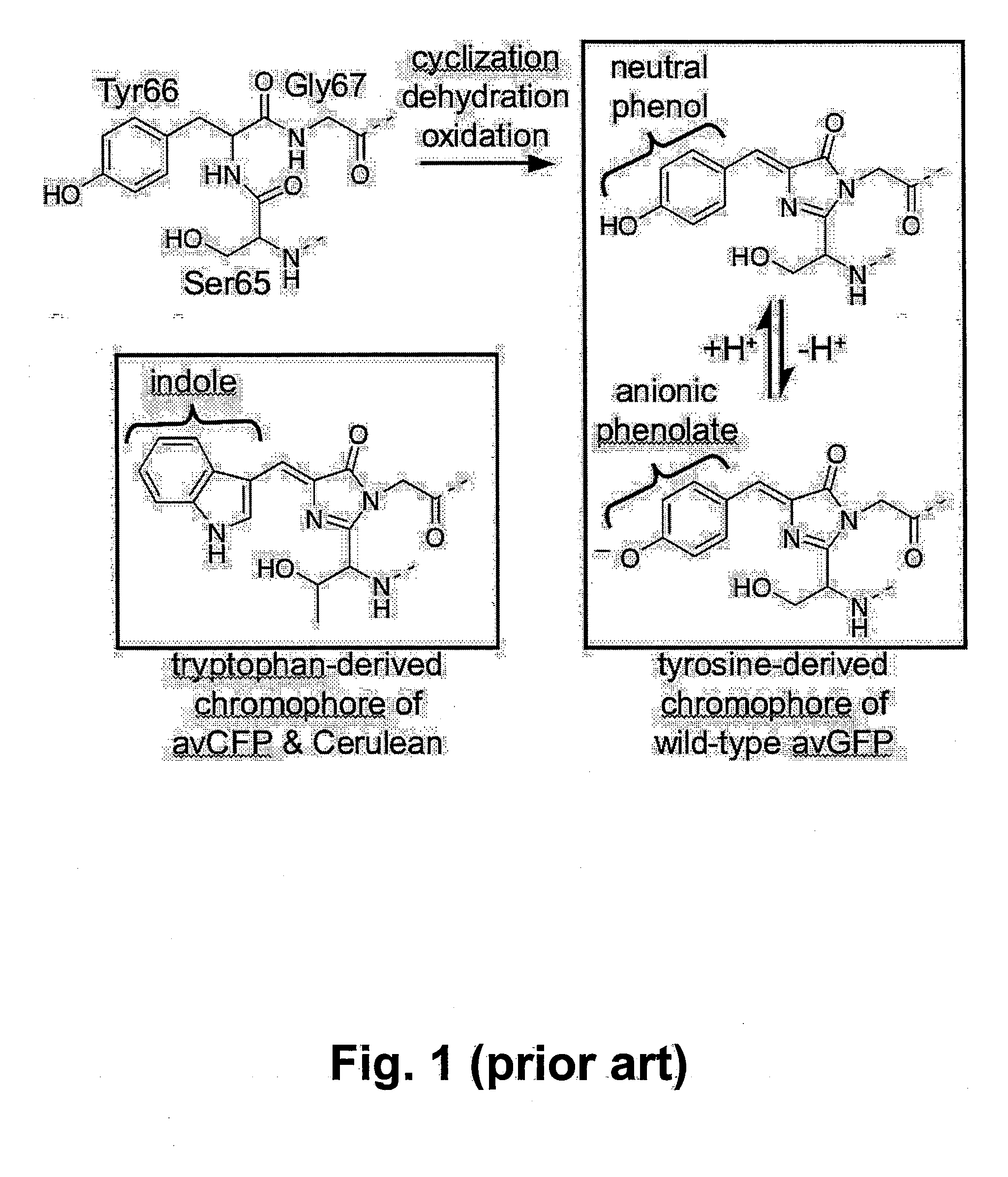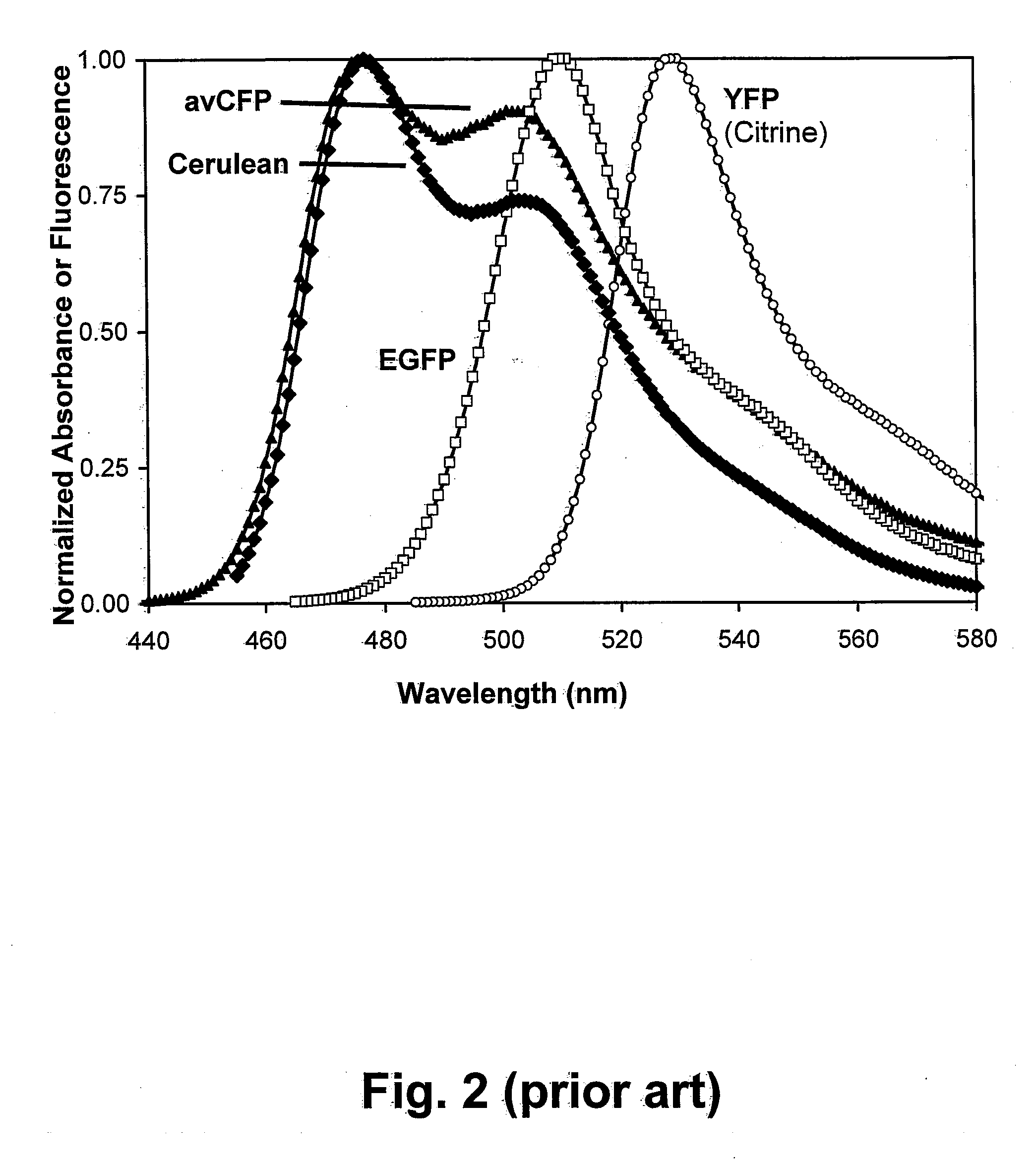TEAL FLUORESCENT PROTEINS (mTFP1)
a fluorescent protein and teal technology, applied in the field of teal fluorescent proteins, can solve the problems of limited use of avcfp in some applications, affecting the use of cerulean and cypet, and limiting the use of avcfp in multi-exponential fluorescence lifetim
- Summary
- Abstract
- Description
- Claims
- Application Information
AI Technical Summary
Benefits of technology
Problems solved by technology
Method used
Image
Examples
example 1
General Methods and Materials
[0079] The synthetic gene library of Clavularia cFP486 variants was commissioned from the DNA Technologies Unit at the NRC Plant Biotechnology Group (Saskatoon, SK). All synthetic DNA oligonudleotides for cloning and construction of subsequent libraries were purchased from Sigma-Genosys Canada (Oakville, ON). PCR products and products of restriction digest were routinely purified using the QIAquick PCR-purification kit according to the manufacturers protocols (Qiagen). Restriction enzymes were purchased from either Invitrogen or New England Biolabs. The cDNA sequences for all TFP variants and fusion constructs was confirmed by dye terminator cycle sequencing using the DYEnamic ET kit (Amersham Biosciences). Sequencing reactions were analyzed at the University of Alberta Molecular Biology Service Unit. The proteins mECFP and mCerulean have the A206K mutation in addition to their characteristic substitutions (Zacharias, 2002; Rizzo, 2004 and 2005).
example 2
Selaction of the Starting Template
[0080] Prior to the present invention, there were three reported naturally-occurring fluorescent proteins with tyrosine-derived chromophores and wavelengths of maximum fluorescence emission at less than 490 nm (Matz, 1999): ClavCFP (a.k.a. ClavFP484) from Clavularia sp., dsCFP (a.k.a. dsFP483) from Discosoma striata, and amCFP (a.k.a. amFP486) from Anemonia majano. At least one other CFP, mcCFP (a.k.a. mcCFP477) from Montastrea cavemosa, has been recently reported (Sun et al., FEBS Lett., 570:175-83, 2004). One other CFP, asCFP (a.k.a. MiCy) from Acropara sp., has a wavelength of.maximum fluorescence of 495 nm, and, therefore, is essentially green (as opposed to cyan) in its fluorescence (Karasawa et al., Biochem. J., 381:307-12, 2004). The naturally-occurring CFPs have quantum yields (QY) of 0.24-0.48 and extinction coefficients (EC) of 24,000-40,000M-1cm-1. All of the naturally-occurring CFPs are oligomers, with some reported to be triners and so...
example 3
Library Construction and Mutagenesis
[0082] The inventors commissioned the synthesis ofthe gene library encoding the designed protein library from the DNA Technologies Unit at the NRC Plant Biotechnology Group. The important features of the designed gene included: mammalian optimized codon usage, deletion of forty residues from the N-terminus, addition of the seven N-terminal and seven C-terminal residues of avGFP, semi-degenerate codons encoding potential “tetramer-breaking” mutations at three external positions, and semi-degenerate codons encoding potential “rescuing” mutations at eleven internal positions (FIGS. 11, 15, and 16). Library quality was verified by sequencing 77 independent clones, of which nine (12%) were confirmed to contain mutations at only the desired positions.
[0083] The initial synthetic gene library was digested with Xho1 and EcoR1 and ligated into similarly digested pBAD / HisB vector (Invitrogen). Subsequent libraries with saturation mutagenesis at a particul...
PUM
| Property | Measurement | Unit |
|---|---|---|
| Fraction | aaaaa | aaaaa |
| Fraction | aaaaa | aaaaa |
| Nanoscale particle size | aaaaa | aaaaa |
Abstract
Description
Claims
Application Information
 Login to View More
Login to View More - R&D
- Intellectual Property
- Life Sciences
- Materials
- Tech Scout
- Unparalleled Data Quality
- Higher Quality Content
- 60% Fewer Hallucinations
Browse by: Latest US Patents, China's latest patents, Technical Efficacy Thesaurus, Application Domain, Technology Topic, Popular Technical Reports.
© 2025 PatSnap. All rights reserved.Legal|Privacy policy|Modern Slavery Act Transparency Statement|Sitemap|About US| Contact US: help@patsnap.com



